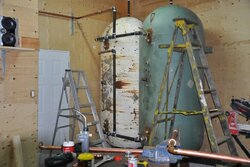Hi all -
I have searched through the topics about building/converting propane tanks into hot water storage tanks for wood boilers, I'll start reading ones comments and get lost cause topics sometimes go sidewyas.
So I was hoping a few of the experienced guys can post thier "directions" on converting( 1) 500g propane tank into storage, then how to add a second later. Including size pipe recommendations, do we put a heat exchanger coil inside, to their favorate websites to buy the parts from, and how does the water heat/move through such a big tank. Since this is for new "do it your selfers", simple and easy would be appreciated.
Now If i missed a topic on this then I'm sorry, and hope someone would post the link here.
Thanks!
I have searched through the topics about building/converting propane tanks into hot water storage tanks for wood boilers, I'll start reading ones comments and get lost cause topics sometimes go sidewyas.
So I was hoping a few of the experienced guys can post thier "directions" on converting( 1) 500g propane tank into storage, then how to add a second later. Including size pipe recommendations, do we put a heat exchanger coil inside, to their favorate websites to buy the parts from, and how does the water heat/move through such a big tank. Since this is for new "do it your selfers", simple and easy would be appreciated.
Now If i missed a topic on this then I'm sorry, and hope someone would post the link here.
Thanks!




